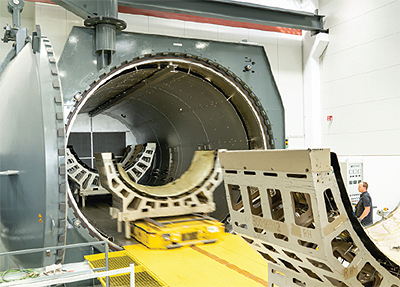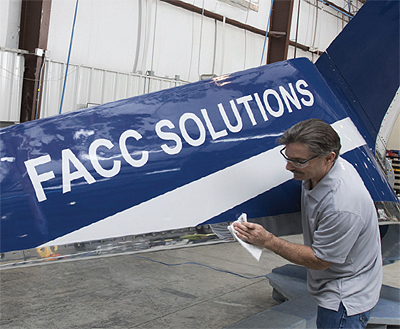FACC: Engineering the Aerospace Future
Thinking of tomorrow
A leading Tier 1 provider, FACC is approaching a turnover of one billion euros due to its versatility and the increased market demand in the global aerospace industry
It is hard not to detect the enthusiasm in Andreas Perotti’s voice, while he is talking us through the major activities FACC is engaged with. What started as a start-up of Austrian sporting goods manufacturer Fischer Ski with just 30 employees in 1989, has now grown into a global corporation providing advanced aircraft components and systems, employing over 3400 staff and operating in 13 countries worldwide. Andreas, Marketing & Communications Director of FACC, begins: “We offer one of the broadest portfolios in the market, as we provide our  technology to every area of the aircraft. Besides, we can serve all different types, be it short, medium, or long-range aircraft, business jets, or helicopters.”
technology to every area of the aircraft. Besides, we can serve all different types, be it short, medium, or long-range aircraft, business jets, or helicopters.”
FACC is organised into three main divisions – Aerostructures, Engines and Nacelles, and Cabin Interiors – having also introduced an Aftermarket Services department this year. Andreas overviews each of the divisions, offering valuable insight into some of the key trends that are shaping the aerospace industry. “Aersostructures is currently our strongest division. There is hardly a type of component we cannot produce. We are engaged in creating wing components, fairings, and control surfaces, examples of which can be access doors, flap ribs, winglets, flap track and pylon fairings, elevators, flaps, and rudders.
“As the name suggests, we manufacture engines and nacelle components through the self-titled division, using predominantly high-tech materials. Our marketing claim is: ‘We design the future of mobility with the materials of tomorrow’, as the sector is increasingly being defined by a strong focus on material competence. We work with materials like fibre and carbon, but also experiment with different ways of production to get more efficient and meet the expectations of our customers. It is essential to shorten production times, because, in the next 15 years, the market will need more aircraft than the industry can currently provide. We will probably need more than 36,000 new passenger aircraft in the said period of time and someone has to build these. With the growth of wealth in countries like China and India, it is easy to see that demand is coming from Asia and its untapped potential determines the promising market environment in which we are operating,” he observes.
The Cabin Interiors division represents another area of growth for FACC. Specialised in activities including cockpit, cabin, and cargo compartment linings, the company is benefitting from the tendency followed by most operators, to retrofit the interior of the aircraft more regularly. “The average operation time for an aircraft is 20 years and, back in the day, the interior was left as it is for the entire length of the operation. Nowadays, it is viewed as normal for a machine to be retrofitted and reequipped up to three times in its lifecycle, to keep the interior fresh and achieve higher passenger comfort,” Andreas notes.
Illustrating FACC’s successful ventures in the division are the back-to-back contracts the company signed with Airbus in September 2017 and July 2018, respectively, amounting to a total of more than 730 million euros. “The former contract encompasses our involvement in Airbus’ new cabin system for the A320 family, as we were chosen to deliver the so-called ‘Airspace XL Bins’, the biggest overhead stowage compartments in the category of short and medium-haul aircraft. Then, this summer we were awarded the follow-up contract that will see us supply the whole entrance area for the entire A320 family.”
 Owing to its USP, the business’ Aftermarket Services division has managed to post a 200 per cent growth in the past two years in the US market alone. “We concentrate on repairing, refurbishing, and replacing such products that we have ourselves made, meaning that we have the knowledge and competence to offer quality support on their maintenance,” Andreas explains. “To give you an example, we have recently developed a new product innovation – the ‘Passenger Luggage Space Upgrade’. It is a bigger door for the existing overhead compartments, which can quickly be installed overnight, thus eliminating the need for any major changes to the interior. The innovation simply opens up more space for the passengers’ luggage, significantly improving the boarding process. This is yet another product we have designed off the back of an existing trend. Travellers tend to be more willing to take their luggage with them on board, instead of dropping it off at the bag drop desk, which creates the need for more space inside the aircraft.”
Owing to its USP, the business’ Aftermarket Services division has managed to post a 200 per cent growth in the past two years in the US market alone. “We concentrate on repairing, refurbishing, and replacing such products that we have ourselves made, meaning that we have the knowledge and competence to offer quality support on their maintenance,” Andreas explains. “To give you an example, we have recently developed a new product innovation – the ‘Passenger Luggage Space Upgrade’. It is a bigger door for the existing overhead compartments, which can quickly be installed overnight, thus eliminating the need for any major changes to the interior. The innovation simply opens up more space for the passengers’ luggage, significantly improving the boarding process. This is yet another product we have designed off the back of an existing trend. Travellers tend to be more willing to take their luggage with them on board, instead of dropping it off at the bag drop desk, which creates the need for more space inside the aircraft.”
It has already become clear that there has to be a tangible upscale in aircraft production for the industry to meet market demands throughout the 2020s and possibly a bit beyond. The business climate offers only one part of the explanation for FACC’s 100 million-euro investment programme undertaken in 2017, the other being the cranked-up volume of contracts the business needs to serve in the coming years. “Our capacities are booked for the next seven years, which means that even if we do not secure a single contract during this time, we will still have to use 100 per cent of our capabilities. We had to make this investment to ensure that we can continue delivering our services on-time. There is no room for problems, because if we cannot deliver, then our customers cannot deliver. We need to be 100 per cent on point when it comes to cost, quality and delivering on time,” Andreas points out.
“As a company, we tend to write up a strategic plan for the decade ahead, which we then break down to individual yearly targets. We are now in the final phase of our 2010s programme and the ultimate target is to reach a turnover of one billion euros, so this will be our top priority in the next couple of years,” he sheds light on FACC’s future intentions. “In the meantime, we will complete our 2020-2030 strategy, taking into account the buoyancy of the market and the greater demand we are facing.
“On top of that, we entered the urban air mobility field. Together with the whole industry, we are searching for ways to use the sky for individual mobility. Cities like London, New York, and Shanghai are so overcrowded that it is becoming more and more time-consuming to get from A to B using the current means of transport. This is why we are interested in applying new technologies that will help us open the sky up for individual mobility,” Andreas concludes promisingly, touching upon the development of potentially game-changing and certainly exciting aerospace innovations.
FACC
Products: Composite components for the aviation industry
